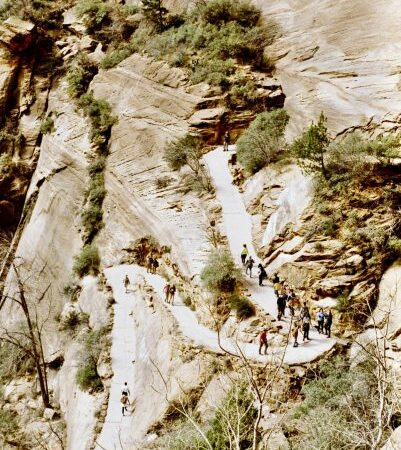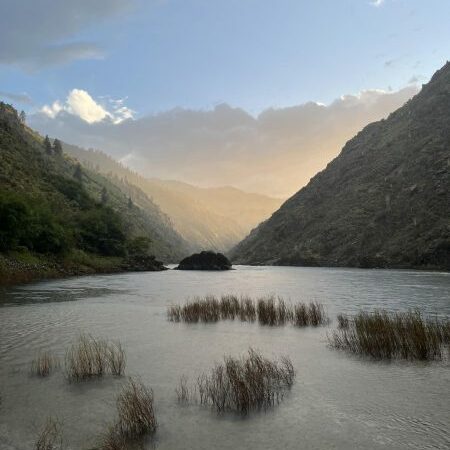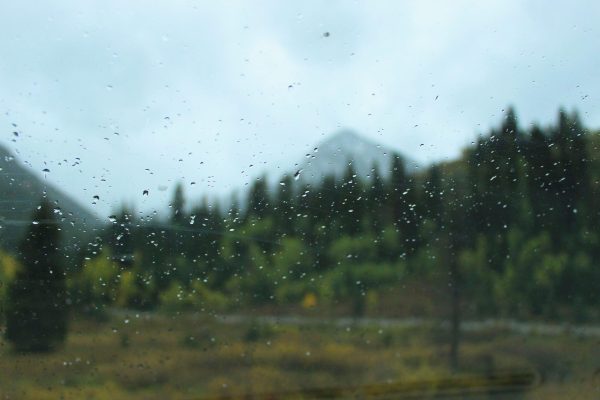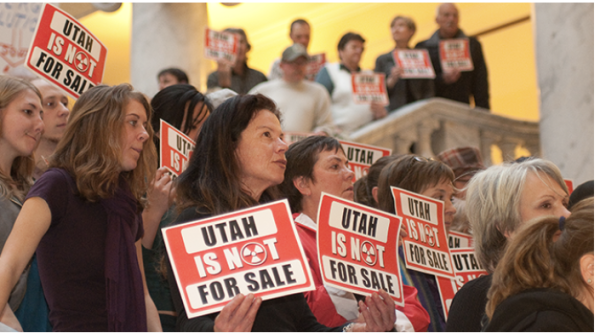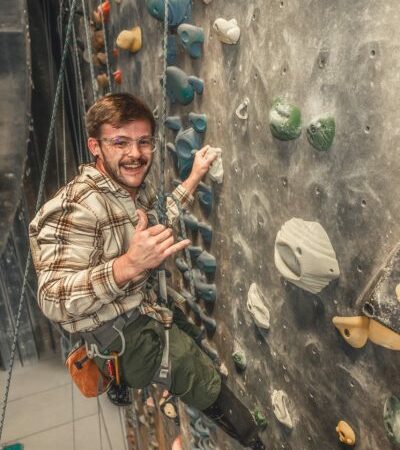CHECKING OFF A SALT LAKE CLASSIC: THE WEST SLABS OF OLYMPUS
From the time I moved to Salt Lake two years ago, the most prominent feature of the Wasatch from my window was always the rocky face of Mount Olympus. I’ve easily stared at the mountain hundreds of times, if not thousands, having the urge to be on top of the peak, looking back at the valley from a different perspective. Someone mentioned within my first year of living here that the most noticeable feature, the smooth slab on the western side of the mountain, was in fact a climbing route, most known for being a fun and relatively easy solo climb. Think Alex Honold on El Cap for his documentary “Free Solo” except instead of a 2,900-foot 5.13a climb on sheer vertical rock, it’s a 1,600-foot, 5.5-graded scramble. This route is known as the West Slabs.
I remember looking up at the rock face in awe (and a bit of terror) after finding out that people regularly run up the rock with nothing more than water in their pack. I have always had a fear of heights and although I was trying to conquer it by doing more outdoor climbing and a bit of canyoneering, the feeling of having a taut rope has always been a safety blanket for me. So, more time went by, and I became more and more comfortable with my climbing skills and the feeling of being exposed on rock. Some friends had climbed the West Slabs while the remnants of our record-breaking winter created icy crevasses in the gully, the approach to the climb. I heard stories of people slipping and sliding on the snow, luckily self-arresting and saving themselves before they crashed into a pile of rocks or fell in a 20-foot gap where the snow ended and the sides of the gully began. It was a no-brainer for me that if I wanted to conquer my fear of heights on this route I would want to wait until no other obstacles, aka a steep snow field, stood in my way.
August rolled around and suddenly, I was energized to take on Olympus, wanting to prove a point to myself and end on a high note for the summer. After expressing my interest, I got invited to climb it on a Friday evening, but descending in the dark didn’t seem very appealing to me. So instead, I rescheduled the outing to that Sunday morning, thinking I’d rather be sweltering in the summer heat than trusting my headlamp to be my eyes. Once Sunday morning rolled around, I was filled with nervous jitters but also excitement, as most people are before a new experience.
Approaching Olympus, the rock face loomed above the Millcreek neighborhood we drove through, and the thought of being on top of the peak in a couple of hours still didn’t seem like a reality. We parked below someone’s driveway and casually strolled onto the trailhead above another person’s home. After about a mile of normal, dirt trail through trees, we turned onto a creek-bed of rocks, and then emerged at the bottom of the gully which framed the main event: the Slabs.
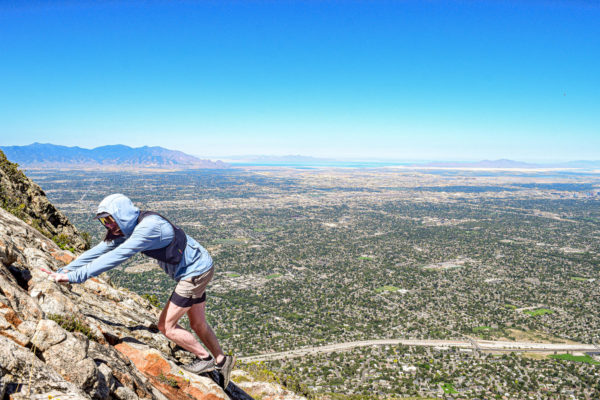
We continued navigating over the field of boulders, slowly gaining elevation in the shadow of the morning, thankful we weren’t getting baked in the heat yet. We made a couple of vertical movements over taller boulders and suddenly we were standing at the base of the route. My climbing partner turned to me after we finished our water break, “Now comes the fun part!”.
After making awkward moves over the scree, the climbing felt secure and effortless. The rock felt as though it was chipped away to make big foot holds and hand jugs. The wall wasn’t even close to the 90-degree sheer terrain I was expecting, despite having seen photos depicting what I was experiencing. After realizing the reality in front of me, I became more comfortable and enjoyed the slow, smooth pace we took as we ascended, getting more and more confident although the ground was getting further and further beneath me. Every once in a while, I would look down between my feet and remind myself how falling could be fatal, but somehow my nerves didn’t get the best of me like they normally do: by giving me the “Elvis Leg” and mentally blocking my motor skills. I was enjoying myself, just beyond stoked to be touching rock outside after a long and boiling summer. But as I would come to experience, I thought too soon.
Before the sun got the best of me, we reached a section of slab which is normally a fun problem-solving part for me while roped up, but at this point, we were 3/4 of the way up. My climbing partner, who had done the West Slabs multiple times before and is a much stronger climber than I, easily found footholds and cleared the slab easily. I tried to follow the same line up but got myself up on a sloping ledge that made me feel uneasy. Calves burning and sweating from anxiety, I carefully retraced my steps until I was back on solid ground, just a bit spooked. Then I looked to my left in search of another way up and saw an obvious sequence of handholds on the jutting-out spine of the rock. Regaining my composure, I reminded myself that I would probably climb no different if I were on rope anyways, and I wouldn’t think twice about it, so onwards and upwards we went.
That last section reinforced what I heard earlier about the West Slabs, that most of it is a “choose your challenge” type climb. There are more technical, riskier sections of course but plenty of comfortable “cruiser” segments that would please anyone who enjoys climbing or high-class scrambling. I clawed over the last couple of rocks below the top and stood gazing out over the valley, realizing that I just took on one of my biggest fears. I was overjoyed and proud. But the part that wouldn’t make anyone happy is the Utah sun beating down on you with no shade to hide in.
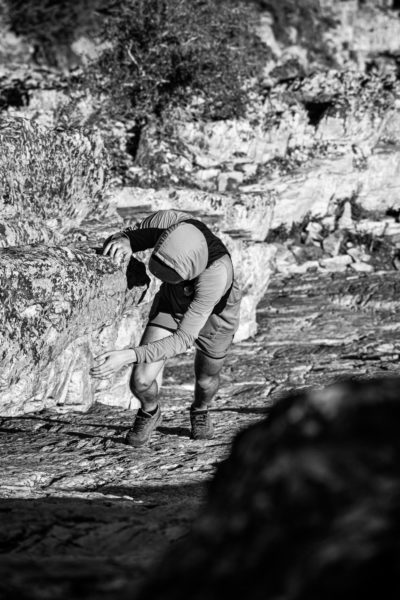
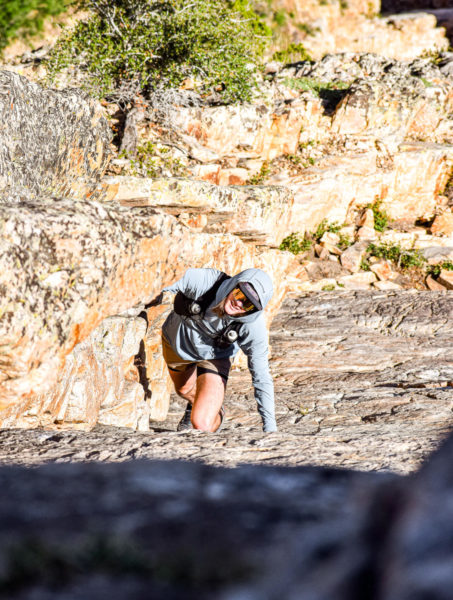
I’m not unaware of the power of the sun at 9,000 feet, I just always seem to have a goldfish memory when it comes to how unpleasant and draining it truly is. I had prepared- or so I thought- by packing a full 3-liter bladder of water in my pack, but I foolishly forgot in my anxious rush out the door to pack something that contained adequate sodium for my water intake. My professor for PRT, Kirk Nichols, walked us through a lecture on the consequences of heat-induced illnesses such as dehydration and heat stroke. He informed us about the factors that might lead to hyperthermia and the solutions to help yourself or a friend when you’re out on an adventure. This lesson replayed in my head as I sat on the ledge above the valley and below the true peak of Olympus. I snacked on a Cliff Bar, hoping that a single energy snack could save the headache that I felt simmering in the back of my skull.
We began our descent down the south-facing backside of the ridge, getting clawed at by bushes and slipping on smaller pebbles, making our way back towards the top of the gully on the north-facing aspect. Footing was unstable but we crawled down the scraggly slope, making it around the corner of the ridge to be standing over the Slabs and the scree field we had conquered about an hour before. The scary part is that now gravity was pulling us down as we descended, trying to make us unbalanced and trip over our feet down the stream of loose rocks. To our right, we had the slab face, to our left we had the steep wall of the gully, and below our feet was what looked like the remnants of a rockslide.
There was loose dirt and varying sizes of boulders littered before us and I already knew that this would take an immense toll on my knees, but there was nowhere to go except down. Cautiously, I began my descent while the effects of dehydration started setting in. I felt as though my head was a balloon, light and woozy and every so often a sharp pain would pierce my temples. More often than not, the rock field was so unstable that you had to sit down and scoot yourself to the next boulder and as we navigated the debris, I wondered about the effects of the past winter on landscapes like this.
For outdoor climbers in the Wasatch, there was a lot of discussion about the melting snow and its impact as it seeps into cracks, freezes, and expands causing features to be destabilized making areas more prone to rock fall. There was a fatal accident that occurred earlier in the summer up Big Cottonwood Canyon that spooked a lot of folks and made everyone more aware of how the wet spring could leave a detrimental mark on the climbing community. From friends who had done the Slabs in June and even July, the snow that covered the gully was a concern because it was hidden in the shade and refused to melt for a while. However, the multiple 100-degree days took care of that, erasing the risk of slipping on ice and replacing it with an unpredictable mess of rocks.
The idea of the past winter and the snow made me thirstier, wishing my water bladder was the temperature of fresh powder rather than freshly brewed tea. After wondering if the descent would never end, seeming as though the gully was stretching in length, we finally stood at the bottom of the Slabs’ route. My knees ached and my head was screaming but we were finally done with the worst of it. After another 15 minutes on rock, we were back on the dirt trail, leading us towards the car.
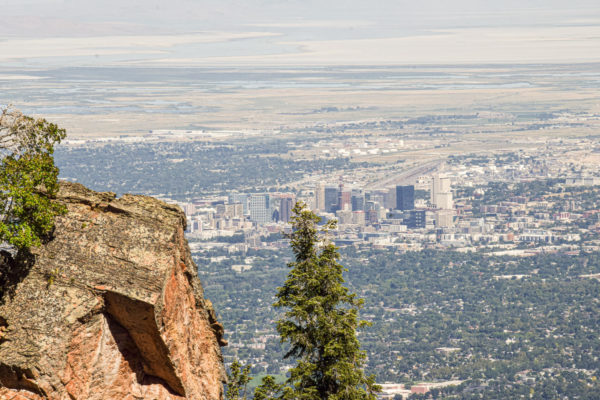
I let out a sigh of relief as I took off my trail running shoes, releasing my feet from sock prison, and didn’t even notice the burning hot car seat as I was too excited to get to the gas station. I hobbled inside and chugged a cup of water as soon as we got to the Chevron, grabbed two Gatorades (blue and yellow) and pressed the cold bottles to my neck. I hopped in the shower as soon as we returned, inspecting the number of cuts and scrapes across my legs as a result of walking through thigh-high bushes, feeling all the sweat, dirt, and dehydration wash off. Now it was time for celebratory greasy food and beer.
When reflecting on the day, there were lots of things I learned. The number one thing I would change is to make sure that my body was properly fueled with food and water, maybe opting for an extra water bottle of electrolytes as the Utah sun takes pity on no one. The second thing I learned was how important having someone who understood the route well was. If I was alone or with some people who were just eager about the adventure, I think it would’ve been a longer, more stressful day out. There are lots of areas where you can get into trouble up on the mountain and so for my peace of mind, it was incredibly helpful to be with someone who had done the route a couple times. Take a reality check of your skills and don’t bite off more than you can chew, written beta can only tell you so much. Third thing I learned was that I trust myself more than I thought. For me to get on the Slabs, I had to believe in my capabilities to make it through without freaking out or messing up. It’s an exciting feeling to push your boundaries and discover a new limit to your comfort. As someone who wouldn’t have even put on a harness to top rope three years ago, this was a rewarding and exhilarating experience. I would recommend anyone else who constantly stares out the window at Olympus to romp up the West Slabs if you can, you might discover more than one new perspective at the top.
The post CHECKING OFF A SALT LAKE CLASSIC: THE WEST SLABS OF OLYMPUS appeared first on Wasatch Magazine.
Source: https://wasatchmag.com/checking-off-a-salt-lake-classic-the-west-slabs-of-olympus/

